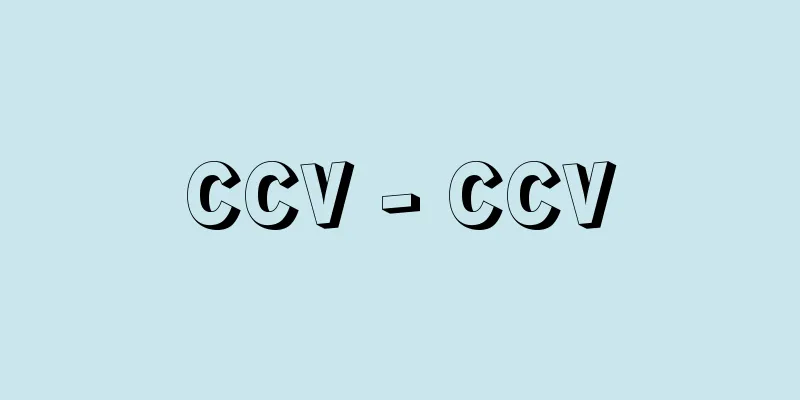CCV - CCV

|
An abbreviation for control-configured vehicle, this is an airplane that is considered one of the directions for the development of aircraft. By equipping the airplane with multiple computers, electrical and hydraulic systems, which are currently installed on board, the system can maintain normal function even if one part fails. By utilizing this characteristic, even if the inherent stability and strength of the aircraft are weakened, it is possible to compensate for this by automatically moving the rudder, making the aircraft smaller and lighter, reducing production and operating costs, and improving performance. An airplane designed with such automated control devices in mind is called a CCV. That is, in order to maintain inherent stability, ordinary airplanes today have tails that are slightly larger than necessary, but in the CCV, the control surfaces are constantly and automatically operated to maintain attitude, so the area of the tail can be kept to a minimum, reducing air resistance and weight. Also, by controlling the control surfaces by computer, it is possible to give the aircraft maneuverability that is completely different from conventional maneuvers. For example, it is possible to change the flight course while keeping the aircraft's attitude constant, or conversely, to fly a constant course while keeping the nose at a certain angle, or to fly while changing attitude along the flight course, which makes landing approaches and combat maneuvers easier. Although it is not yet in practical use, this feature is a great attraction for military aircraft, so research and development is being actively carried out around the world. [Kazuo Ochiai] ©Shogakukan "> T2 CCV (experimental aircraft) and CCV flight characteristics… Source: Shogakukan Encyclopedia Nipponica About Encyclopedia Nipponica Information | Legend |
|
control-configured vehicleの略で、航空機の発展方向の一つと考えられる飛行機。現在も機上に取り付けられているコンピュータや電気・油圧系統を多重装備することによって、たとえ一部に故障を生じてもシステムの機能を正常に保たせることができる。この特性を利用すると、飛行機固有の安定性や機体の強度を弱くしても、舵(かじ)を自動的に動かすことによってそれを補うことができ、機体を小型・軽量化して、生産・運航コストの節減や性能の向上を図ることができる。このような自動化された操縦装置をあらかじめ考慮に入れて設計された飛行機をCCVとよんでいる。 すなわち、現在の普通の飛行機では固有の安定性を保たせるため、必要とするよりやや大きめの尾翼をもたせているが、CCVでは常時自動的に舵面を操作して姿勢を保たせるので、尾翼の面積を最小限の大きさに抑えることができ、空気抵抗や重量を節減できる。また、舵面をコンピュータ操作させることで、従来とまったく異なった運動性をもたせることができる。たとえば、飛行機の姿勢を一定に保ったまま飛行コースを変えたり、逆に機首方向をある角度に保ったまま一定のコースを維持して飛行したり、あるいは飛行コースに沿って姿勢を変えながら飛行するなどの運動ができ、その結果着陸進入や戦闘行動が容易になる。現在はまだ実用化されてはいないが、この特徴は軍用機にとって大きな魅力であるため、世界各国でさかんに研究・開発が続けられている。 [落合一夫] ©Shogakukan"> T2 CCV(実験機)とCCVの飛行特… 出典 小学館 日本大百科全書(ニッポニカ)日本大百科全書(ニッポニカ)について 情報 | 凡例 |
<<: Shishi Bunroku - Shishi Bunroku
Recommend
Uspenskaya Cathedral
...Some of the murals in the former church contai...
Committed crime - Kisuihan
A crime that has been completed. A crime that full...
Kecak - Kecha (English spelling) kecak
A performing art performed on the island of Bali ...
Plouton (English spelling)
…His name means “the invisible one.” In Roman myt...
Red vinegar - Akazu
1. A dark-colored vinegar made from well-aged sake...
Ludwig I (King of Bavaria)
…She was born in Ireland as the daughter of a Bri...
Smoking - Kisso
…This book was written by Eisai, who introduced t...
Electrical insulating paper
A general term for paper used for electrical insul...
Ionization voltage - Ion cadence
[ I ] Ionization voltage. [Synonym] Ionization po...
Tiziano Vecellio
A Venetian painter of the Italian High Renaissanc...
Noël Du Fail
1520?-91 French storyteller. He was a Burgundian n...
Glasscobo Culture - Glasscobo Culture
An early Bronze Age culture in Trans-Baikal, Russi...
Grolier, J.
…The spine bands remain longer in books from Engl...
Fluorography
...A general term for photography using ultraviol...
Oliver Wendell Holmes
1841‐1935 American jurist. Born in Massachusetts. ...









